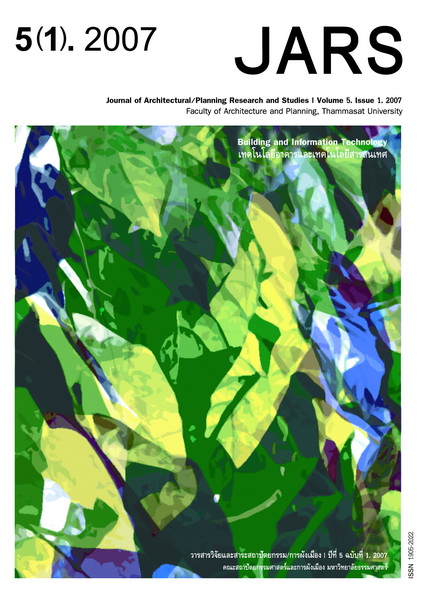Guidelines for Lighting Design in Multimedia Classroom
Main Article Content
Abstract
Due to the technological development, the conventional classroom cannot fully support the use of
new teaching media, especially in terms of quality and quantity of light. This research aims to propose
lighting design guidelines for multimedia classroom through experimental study in real classroom and
lighting simulation by using DIALux program. The research found that the blind could be adjusted from 30 –
60 degree to achieve visual comfort and benefit of daylight. Installing shading device and light shelf related
to the sun position can reflect daylight deeply and stably. The appropriate artificial lighting plan and control
increase lighting efficiency and reduce energy consumption. For better vision, brightness ratio between side
area and screen should be 1: 5 and the reflectance property of the side area should not exceed 40%. The
results of this research can be used for lighting design in multimedia classroom to create suitable learning
environment.
Downloads
Article Details

This work is licensed under a Creative Commons Attribution-NonCommercial-NoDerivatives 4.0 International License.
All material is licensed under the terms of the Creative Commons Attribution 4.0 International (CC-BY-NC-ND 4.0) License, unless otherwise stated. As such, authors are free to share, copy, and redistribute the material in any medium or format. The authors must give appropriate credit, provide a link to the license, and indicate if changes were made. The authors may do so in any reasonable manner, but not in any way that suggests the licensor endorses you or your use. The authors may not use the material for commercial purposes. If the authors remix, transform, or build upon the material, they may not distribute the modified material, unless permission is obtained from JARS. Final, accepted versions of the paper may be posted on third party repositories, provided appropriate acknowledgement to the original source is clearly noted.
References
Kaufman, J. E., & Haynes, H. (Eds.). (1981). IES lighting handbook: Reference volume. New York: Illuminating Engineering Society of North America.
Smith, P. H. K. (1979). Upgrading lecture rooms. London: Applied Science Publishers.
น้ำผึ้ง สายหงษ์. (2549). แนวทางการออกแบบห้องเรียนสื่อผสม. วิทยานิพนธ์สถาปัตยกรรมศาสตรมหาบัณฑิต คณะสถาปัตยกรรมศาสตร์และการผังเมือง มหาวิทยาลัยธรรมศาสตร์.
Chutarat A., & Norford L. K. (2002). A new design process using an inverse method: A genetic algorithm for daylighting design. Journal of Architectural Research and Studies, 1, 25-41.
สุรีพรรณ สุพรรณสมบูรณ์. (2544). อิทธิพลของตัวแปรที่มีผลต่อการนำแสงธรรมชาติด้านข้างเข้ามาใช้ภายในอาคาร. วิทยานิพนธ์สถาปัตยกรรมศาสตรมหาบัณฑิต จุฬาลงกรณ์มหาวิทยาลัย.


